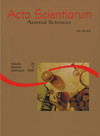<b>Digestible energy Levels on the piauçu (<em>Leporinus macrocephalus</em>)performance</b> - DOI: 10.4025/actascianimsci.v29i1.266
Abstract
The objective of this study was to evaluate the effect of energy levels on the piauçu (Leporinus macrocephalus) productive performance. Two hundred and fifty post larvae,average initial weight and length of 0.56 ± 0.02 g and 3.60 ± 0.42 cm respectively, wereassigned to 25 aquariums with 100 L and stocking rate of 10 fishes/aquarium. The experiment was carried out according to a completely randomized design, with 5 treatments (2600, 2700, 2800, 2900 and 3000 kcal DE kg-1 of a isoprotein ration with 28% CP) and five replications. Viscera-somatic index did not differ among treatments. Final weight, weightgain, protein efficiency rate and survival rate were not affected by the energy level. Linearincrease of digestible energy intake and decreasing linear effect of energy levels on carcassprotein content, as dietary digestible energy level increased, were observed. The level of 2,700 kcal DE kg-1 showed the higher protein values. A positive linear effect among the dietary DE levels and fat content and the fat percentage in weight gain were also observed,which increased in a quadratic way up to the level of 2,821 kcal DE kg-1. The digestible energy requirement for piauçu fingerlings in the post larvae phase is 2,700 kcal DE kg-1.Downloads
Download data is not yet available.
Published
2007-11-13
How to Cite
Navarro, R. D., Lanna, E. A. T., Donzele, J. L., Matta, S. L. P. da, & Souza, M. A. de. (2007). <b>Digestible energy Levels on the piauçu (<em>Leporinus macrocephalus</em>)performance</b> - DOI: 10.4025/actascianimsci.v29i1.266. Acta Scientiarum. Animal Sciences, 29(1), 109-114. https://doi.org/10.4025/actascianimsci.v29i1.266
Issue
Section
Animal Production
DECLARATION OF ORIGINALITY AND COPYRIGHTS
- I Declare that current article is original and has not been submitted for publication, in part or in whole, to any other national or international journal.
The copyrights belong exclusively to the authors. Published content is licensed under Creative Commons Attribution 4.0 (CC BY 4.0) guidelines, which allows sharing (copy and distribution of the material in any medium or format) and adaptation (remix, transform, and build upon the material) for any purpose, even commercially, under the terms of attribution.
Read this link for further information on how to use CC BY 4.0 properly.
0.9
2019CiteScore
29th percentile
Powered by 








































